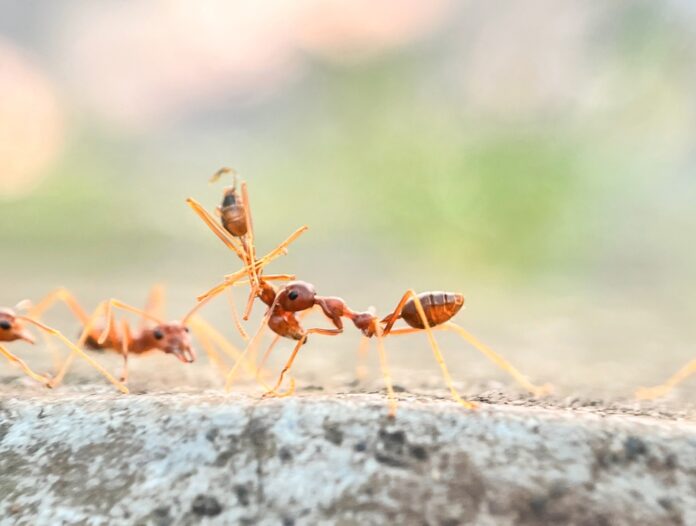Up until recently, humans have been known as the only species to surgically remove limbs to increase a wounded individual’s chances of survival. Chimps have medically treated injuries of the wounded, ants have carried inebriated nest mates home to sleep it off — but selectively amputating limbs to save the life of another is distinctly a human behavior.
But Erik Frank, a biologist at the University of Würzburg, recently discovered that when the leg of a Camponotus floridanus ant was injured, its nest mates would bite it over and over again until it pulled cleanly away from the body. To save the injured ant, its nest mates surgically removed the limb.
“At the beginning, I thought we made some mistake or the experiment wasn’t working correctly,” says Frank, whose results were published last month in Current Biology. “We’ve never seen [amputation] anywhere before.”
Are Ants Empathetic and Do They Have Feelings?
Frank found that the ants also didn’t do surgery on every leg injury — only injuries that had 100 percent chance of recovery following amputation. The ants didn’t bother with surgery on those injured at the tibia, a wound that has low survival rates.
C. floridanus wasn’t just identifying the type of injury a nest mate had, it was also calculating if surgical intervention would likely to lead to survival.
But while this new research shows the complexity of C. floridanus’ social behavior, it also poses a question: Are these ants surgically extending the lives of wounded nest mates because they, like humans, empathize with the pain of injury and the threat of death?
“There is a growing amount of research that shows empathy to be more widespread in the animal world than many used to presume,” says University of Turku, Finland philosopher Elisa Aaltola. “We have become blind to the different forms mental abilities such as empathy can take in other species.”
Read More: Do Insects Have Feelings and Consciousness?
Debating the Significance of Amputation
But just because C. floridanus practices a similar form of amputation, that doesn’t mean that the behavior has similar significance to its species, says Frank.
“An ant society is nothing like a human society,” Frank explains. “An ant society is a super organism [in which each ant functions] like the cells in a body. We have cells that heal other cells, but we wouldn’t say that those cells have empathy.”
In contrast, Aaron Sandel, a University of Texas Austin primatologist, isn’t so sure.
“I would be hesitant to throw out the possibility that wound care in ants is necessarily so different than what it is in a mammal,” Sandel says.
Sandel’s work focuses on chimpanzees at Ngogo in Uganda’s Kibale National Park, a community in which he’s witnessed other-directed wound care. He also observed the coaxing of a mortally wounded animal to return home to the group – an example of animal empathy.
Read More: 5 of the World’s Most Intelligent Animals
Empathy in the Animal Kingdom
There are other studies that provide strong evidence that animals may be capable of empathy, too. Rats, for example, can recognize if another rat is in distress inside a water-filled chamber. In a study, a rat learned to pull a chain to save the other rat from drowning. Dogs also show empathy for other species.
“Dogs can resonate with the emotions of the people in their lives,” Aaltola explains. “From an evolutionary perspective, it would make sense that species who cooperate or exist in symbiosis would also be capable of feeling some amount of empathy across the species border.”
A growing body of research suggests that, in the insect world, ants are among the most promising species for exploring the existence of empathy. In addition to amputating wounded femurs, researchers have found that the nest mates of an ant who has been tethered and trapped under sand and pebbles will attempt to rescue them by pulling on their extremities and biting through the tether.
Even some of Frank’s previous research, a 2017 study on African termite-hunting ants (Megaponera analis), witnessed something that, in humans, would be considered empathetic behavior: Ant soldiers carried wounded comrades back to the nest after a raid.
Read More: The Complex Ways Humans Empathize With Other Animals
Emotional Behavior Compared to Humans
Frank thinks it’s unlikely that the rescuing behavior observed in termite-hunting ants involves empathy — rescuing the wounded so that they can recover and rejoin the community is not necessarily for the benefit of the individual, but for the colony as a whole. But Lars Chittka, professor of sensory and behavioral ecology at Queen Mary University of London, has a different interpretation.
“The truth is that, of course, ants are anything but just cells of a super organism, they are individuals with individual motivations, memory, cognitive skills, etcetera,” Chittka says.
If ants display behaviors similar to empathetic behaviors, we can compare this to emotions in humans. It is, Chittka says, entirely plausible that an emotional state is involved.
Paradoxically, says Aaltola, the less we empathize with certain animal species, the more likely we are “to presume that they have no empathy.” According to Aaltola, “If we cannot resonate with or intellectually recognize the existence of the internal states of others, we will become incapable of perceiving them as minded creatures.”
Sandel agrees, “With empathy and emotions, we’re dealing with 100 years of psychologists and biologists saying it doesn’t exist in non-human animals. What else are we missing because we’re just not looking for it?”
Read More: Do Animals Fall in Love?
Article Sources
Our writers at Discovermagazine.com use peer-reviewed studies and high-quality sources for our articles, and our editors review for scientific accuracy and editorial standards. Review the sources used below for this article:
Source : Discovermagazine









